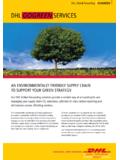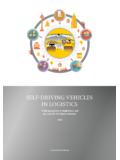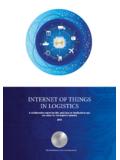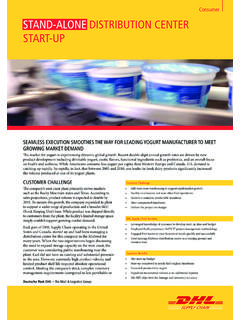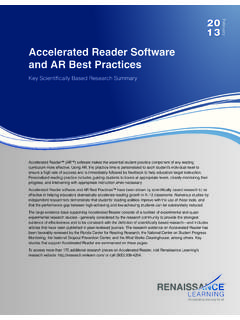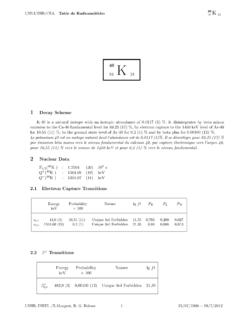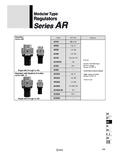Transcription of AUGMENTED REALITY IN LOGISTICS - dhl.com
1 AUGMENTED REALITYIN LOGISTICSC hanging the way we see LOGISTICS a DHL perspective2014 Powered by DHL Trend ResearchPUBLISHERDHL Customer Solutions & InnovationRepresented by Matthias Heutger,Senior Vice President Strategy, Marketing & Development, DHL CSI53844 Troisdorf, GermanyPROJECT DIRECTORDr. Markus K ckelhausDHL Trend Research PROJECT MANAGEMENT AND EDITORIAL OFFICEGina ChungDHL Trend ResearchIN COOPERATION WITH:AUTHORSH olger Glockner, Kai Jannek, Johannes Mahn, Bj rn Theis1 The next big wave of change in the LOGISTICS industry might just come in the form of AUGMENTED Realitytechnology. From personal computers to mobile devices, we know that technology can profoundly alter the way we commu-nicate and interact with the world.
2 New technologies im-pact almost every industry, and LOGISTICS is no potential for AUGMENTED REALITY in the LOGISTICS industry has already been highlighted in the acclaimed DHL LOGISTICS Trend Radar . This overarching study is a dynamic living document designed to help organizations derive new strategies and develop more powerful projects and innovations. This trend report intends to deepen your understanding of AUGMENTED REALITY and answer the key questions: What is AUGMENTED REALITY all about? How far has this technology developed; are there some examples of best practice? What are the implications for AUGMENTED Realityin the LOGISTICS industry?Jointly developed with Z_punkt the Foresight Company, a specialty consultancy for strategic future planning, trend analysis, and new technologies, this report goes beyond the recent media hype to offer real-world use cases, revealing what s going on now, and what s likely tohappen in the future.
3 We hope that AUGMENTED REALITY in LOGISTICS sparks your interest and enthusiasm for this exciting, emerging topic and provides you with new insights. Thank you for choosing to join us on this journey, which we believeis about to take off shortly. Yours sincerely,PrefacePREFACEM atthias Heutger Dr. Markus K ckelhaus22 Preface .. 11 Understanding AUGMENTED REALITY .. 3 From Digital Gimmickry to Revolutionizing Business? .. 4 Hardware Overview .. 52 AUGMENTED REALITY Best Practice .. 7 Context-sensitive Information Information at the Right Time and Place .. 7 Enhanced Senses Becoming Human .. 8 Mixed- REALITY Simulations Exploring the Virtual in the Real.
4 10 Virtual Interfaces Controlling the Real Through the Virtual .. 11 3 AUGMENTED REALITY in LOGISTICS .. 13 Warehousing Operations .. 13 Transportation Optimization .. 15 Last-mile Delivery .. 17 Enhanced Value-added Services .. 19 Outlook .. 21 Sources .. 22 Table of Contents3 Understanding AUGMENTED RealityImagine your car breaks down in the middle of the highway. You know very little about vehicle mechanics, and the next garage is miles away. Today, this breakdown is likely to cost you lots of time and money to fix; but tomorrow, it may be no more than a minor glitch in your day. Using your smart glasses, you ll be able to launch your repair app and assess the problem through yournormal line of sight accompanied by a step-by-step repair guide for your particular make and model of car, without the help of a imagine you re out shopping, and want to know how other consumers have rated a jacket that you re thinkingof buying.
5 By glancing down at the product with your smart glasses, you ll instantly see extra information displayed alongside the jacket user ratings, product price range, and supply information all of which empowers your purchasing decision. This is AUGMENTED REALITY (AR) where every object you see could be enriched with additional and valuable information. AR is defined as the expansion of physical REALITY by adding layers of computer-generated informa-tion to the real Information in this context could be any kind of virtual object or content, including text, graphics, video, sound, haptic feedback, GPS data, and even smell. But AR is more than a simple displaying technology.
6 It also represents a new type of real-time natural user interface for human interaction with objects and digital is made possible by performing four basic and distinct tasks, and combining the output in a useful way. 1. Scene capture: First, the REALITY that should be AUGMENTED is captured using either a video-capture device such as a camera, or a see-through device suchas a head-mounted Scene identification: Secondly, the captured REALITY must be scanned to define the exact position where the virtual content should be embedded. This position could be identified either by markers (visual tags) or by tracking technologies such as GPS, sensors, infrared, or Scene processing: As the scene becomes clearly recognized and identified, the corresponding virtual content is requested, typically from the Internet or from any kind of Scene visualization: Finally, the AR system producesa mixed image of the real space as well as the virtual also differentiate between AUGMENTED REALITY and Virtual REALITY (VR).
7 VR is a completely computer-generated, immersive and three-dimensional environment that is displayed either on a computer screen or through special stereoscopic displays, such as the Oculus Rift. In contrast, AR (or Mixed REALITY as it is also sometimes called) combines both the virtual and the real. Users of AR are still able to sense the real world around them; this is not possible when people are immersed in UNDERSTANDING AUGMENTED REALITY1 Carmigniami et al. (2011): AUGMENTED REALITY : An Overview. In: Carmigniami; Furth (eds.): Handbook of AUGMENTED REALITY , Springer, New York, 2011, pp. 3 46 Figure 1: Basic Functionality of AUGMENTED REALITY ; Source:FunctionalityScene Identifi cation2 Scene Processing3 Scene Capture1 Scene Visualization44 Understanding AUGMENTED From Digital Gimmickry to Revolutionizing Business?
8 Despite the surge in widespread media coverage over the past 12 months, the majority of AR solutions that we read about today are still in development. Only a few hardware solutions are being mass produced and readily available to purchase off the shelf. Just a couple of years ago, there were only a handful of available commercial AR applications in fact the first AR app for the iPhone was not released until In 2011, global AR revenues were as low as USD 181 million3 and, at that time, AR was often perceived by the public as just a marketing gimmick: a technology in search of a useful application. There was little public awareness, and applications were primarily developed to gain quick PR wins, or their value was limited to attention-grabbers such as adding video Yelp s monocle feature.
9 For further info see: Ben Parr (2009): Easter Egg. Yelp Is the iPhone s First AUGMENTED REALITY App. Online at: Research and Markets (2011): Global AUGMENTED REALITY Market Forecast by Product for Gaming, Automotive, Medical, Advertisement, Defense, E-Learning & GPS Applications Expected to Grow to $5, Million by 2016 4 CNET (2013): Th e next big thing in tech. Online at: , latest forecasts predict that by 2017 theAR market will grow to USD billion an impressive annual increase of almost 100 %. With substantial funding being poured into AR projects and start-ups, especially by large corporations such as Google, Canon, and Qualcomm, we can expect the first significant wave of consumer-ready AR products to be launched over the next 12 months.
10 And withconcrete business benefits coming to light, expertsare convinced that AR will be the next big thing inthe consumer, medical, mobile, automotive, and manufacturing is no longer just a marketing ploy. We will see continued uptake of AR and, as it grows, its application will be accelerated by technological progress.$6,000 Global AR Revenues 2012 to 2017,by market segment, in million US-$$020122017 EnterpriseMultimedia &EntertainmentLifestyle &HealthcareGamesSocial NetworkingLocation BasedMillion US-$Figure 2: Global AR Revenues 2012 2017 (estimate); Source: Xcubelab5 Understanding AUGMENTED RealityBy looking at the types of AR platform currently available, and predicting what lies ahead, the following AR items can be identified today: Handheld Devices Stationary AR Systems Spatial AUGMENTED REALITY (SAR) Systems Head-mounted Displays (HMDs) Smart Glasses Smart Hardware OverviewBoth the development and implementation of AR software solutions rely, in turn, on the development of suitable and robust AR hardware platforms.



